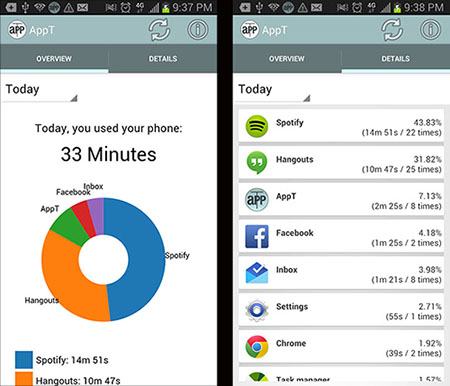New App Sheds Light on Phone Usage
AppT allows you to track, monitor, and analyze mobile device usage
A year ago, PhD student John Rula accidentally left his smartphone in a taxi. After exiting the car, he checked his pockets multiple times only to find them empty. That’s when the anxiety set in.
 “I felt like my phone was my only connection to the outside world,” he said. “Of course that’s not entirely true because I still had my computer. But I just have this strange attachment to my phone.”
“I felt like my phone was my only connection to the outside world,” he said. “Of course that’s not entirely true because I still had my computer. But I just have this strange attachment to my phone.”
Rula relayed the incident to his adviser Fabián Bustamante, a professor of electrical engineering and computer science. They discussed how many people perhaps rely too much on their mobile devices and feel separation anxiety when it’s missing. Inspired by the conversation, the duo decided to develop an application to help people control this “dependency”.
After multiple iterations, Bustamante and Rula came up with Application Time, or AppT, an app that enables its users to track, monitor, and analyze their mobile device usage. The team hypothesized that most people look at their phones mindlessly, without realizing how much time they spend on different applications.
“Unlocking your phone time and again throughout the day has become a subconscious habit,” Bustamante said. “Recognition is the first step in behavior change.”
 Now available for Android in the Google Store, AppT runs every time the phone’s screen is on. Every 1.5 seconds, it records which app is in the foreground. It then displays visualizations to show which apps have been used, how frequently, and for how long. And because AppT has very low demands and does not run when the screen is off, it does not drain the phone’s battery.
Now available for Android in the Google Store, AppT runs every time the phone’s screen is on. Every 1.5 seconds, it records which app is in the foreground. It then displays visualizations to show which apps have been used, how frequently, and for how long. And because AppT has very low demands and does not run when the screen is off, it does not drain the phone’s battery.
Rula used AppT for a year, and what he discovered surprised him. He found he used a chat and messaging app more than 11,000 times over the course of a year, averaging about 23 times a day. And most of his usage occurred in the afternoon — right in the middle of his workday.
“I didn’t even realize how much I was looking at my phone while sitting at the computer,” he said. “This constant distraction was terrible for my productivity.”
While AppT helps people monitor their own behaviors, Bustamante and Rula believe that what they learn through this new tool can also potentially be used to improve future applications and mobile devices.
“Knowing my usage patterns, my phone could prepare my next app to use, so I don’t have to swipe 10 screens to get to it,” Bustamante said. “Users could pre-load what those apps need over the network or delay updates perhaps knowing that I will walk into my home WiFi shortly.”